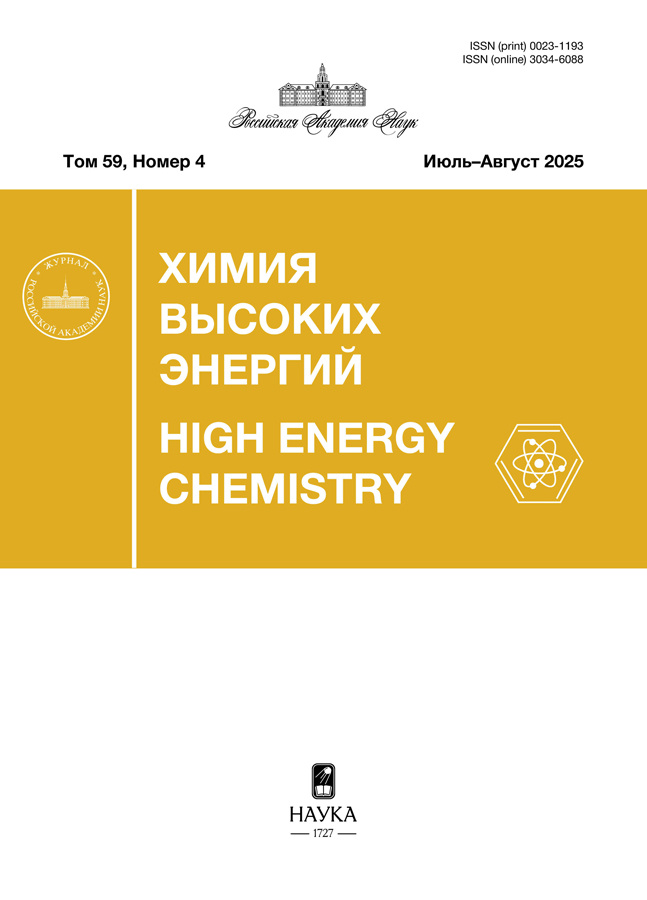Influence of diluent on alkylmalonamide radiolysis
- Authors: Khalikov T.V.1, Kholodkova E.M.1, Ponomarev A.V.1
-
Affiliations:
- Frumkin Institute of Physical Chemistry and Electrochemistry RAS
- Issue: Vol 59, No 4 (2025)
- Pages: 223-228
- Section: RADIATION CHEMISTRY
- URL: https://cardiosomatics.ru/0023-1193/article/view/687892
- DOI: https://doi.org/10.31857/S0023119325040054
- EDN: https://elibrary.ru/ayaarw
- ID: 687892
Cite item
Abstract
The radiolysis of the extractant N1,N3-dimethyl-N1,N3-dibutyltetradecylmalonamide and its 30% solution in n-tridecane under the action of 3 MeV electrons was studied. The key radiolytic processes are fragmentation of the extractant molecules. The decomposition is predominant along the bonds located in the β-position relative to the carbonyl group: N-Me, N-Bu, C-C14H29 and C-C(O). The C-C(O) bond is the weakest – its cleavage gives more than half of all the extractant degradation products. The observed yield of extractant degradation in solution is almost one and a half times higher than in the undiluted state. At the same time, a decrease in the yield of diluent degradation is observed in the solution. The observed effects indicate partial physical and chemical protection of the diluent by the dissolved extractant.
Keywords
Full Text
About the authors
T. V. Khalikov
Frumkin Institute of Physical Chemistry and Electrochemistry RAS
Email: ponomarev@ipc.rssi.ru
Russian Federation, Moscow
E. M. Kholodkova
Frumkin Institute of Physical Chemistry and Electrochemistry RAS
Email: ponomarev@ipc.rssi.ru
Russian Federation, Moscow
A. V. Ponomarev
Frumkin Institute of Physical Chemistry and Electrochemistry RAS
Author for correspondence.
Email: ponomarev@ipc.rssi.ru
Russian Federation, Moscow
References
- Evsiunina M.V., Matveev P.I., Kalmykov S.N., Petrov V.G. // Moscow Univ. Chem. Bull. 2021. V. 76. P. 287
- Matveev P.I., Mohapatra P.K., Kalmykov S.N., Petrov V.G. // Solvent Extr. Ion Exch. 2021. V. 39. P. 679.
- Yang Y., Walton A., Sheridan R., Güth K., Gauß R., Gutfleisch O., Buchert M., Steenari B.-M., Van Gerven T., Jones P.T., Binnemans K. // J. Sustain. Metall. 2017. V 3. P. 122.
- Modolo G., Vijgen H., Serrano‐Purroy D., Christiansen B., Malmbeck R., Sorel C., Baron P. // Sep. Sci. Technol. 2007. V. 42. P. 439.
- Poinssot C., Rostaing C., Baron P., Warin D., Boullis B. // Procedia Chem. 2012. V. 7. P. 358.
- Aderibigbe A.D., Day D.P. // ChemistrySelect. 2020. V. 5. P. 15222.
- Delavente F., Guillot J.-M., Thomas O., Berthon L., Nicol C. // J. Photochem. Photobiol. A Chem. 2003. V. 158. P. 55.
- Delavente F., Guillot J.-M., Thomas O., Berthon L., Nicol C. // J. Photochem. Photobiol. A Chem. 2004. V. 162. P. 81.
- Ponomarev A.V. // Chem. Eng. J. Adv. 2023. V. 15. P. 100513.
- Metreveli A.K., Ponomarev A.V. // High Energy Chem. 2016. V. 50. P. 254.
- Traven V.F., Organic chemistry [Electronic resource]: textbook for universities: in 3 volumes. BINOM. M.: Knowledge Laboratory, 2015.
- Woods R., Pikaev A. Applied radiation chemistry. Radiation processing. NY: Wiley, 1994.
- Vlasov S.I., Kholodkova E.M., Ponomarev A.V. // High Energy Chem. 2021. V. 55. P. 393.
- Serenko Y.V., Ponomarev A.V., Belova E.V. // High Energy Chem. 2021. vol. 55. p. 482.
Supplementary files


















